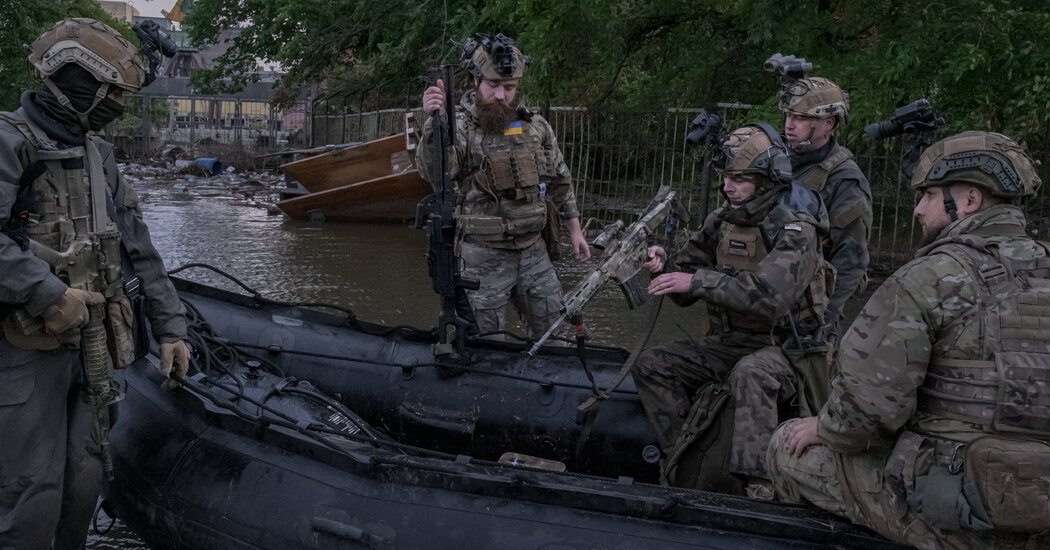Ukraine claimed small advances on Monday in its counteroffensive in the southeast of the country, hunting for a place to drive a wedge through Russian defenses, a key to its hopes for recapturing wide swaths of territory lost to the Russian invasion last year.
After a week of fierce combat with infantry, artillery and tanks, across a mostly agricultural landscape, Ukrainian forces, newly armed and trained by Western allies, have retaken seven small villages and settlements, Hannah Malyar, a deputy defense minister, wrote on the messaging platform Telegram, including one that the military said it had captured on Monday.
The deepest advance was about 4 miles, and “the area of territory taken under control is 90 square kilometers,” about 35 square miles, she wrote.
The significance of those gains remains to be seen, and military analysts have said it will take weeks or months, not days, to gauge the success of the offensive Ukraine began last week across a broad stretch of the front lines in the Donetsk and Zaporizhzhia regions. Progress is measured in yards, or at most a mile or so, the Ukrainian gains have involved tiny farming villages, and there has been no sign so far of a significant break in the Russian occupiers’ dense network of defenses.
Ukraine’s multipronged counteroffensive is likely to employ probing attacks and feints, with the bulk of the attacking force held in reserve, military analysts have said, looking for a weakness and then throwing its weight in that direction. Ukraine has not disclosed losses, but its attacks against Russian trenches, bunkers, minefields and gun emplacements are likely to be taking a heavy toll on its forces, analysts say, and there have been some confirmed losses of both troops and advanced weaponry newly donated by allies.
It appeared that flooding after the destruction of the Kakhovka dam on the Dnipro River in southern Ukraine had not slowed the advance of Kyiv’s forces, which have not attempted to cross the river. Ukraine has accused Russia, which controlled the dam, of destroying it. Engineering and munitions experts have said that the dam was probably breached by an explosion from the inside, not by shelling or other external attacks, and not by a structural failure.
The armies may not have been much affected, but the collapse of the dam before dawn on June 6 has been devastating to many thousands of civilians, inundating their homes and workplaces and forcing them to flee. For those who remain, the river at the heart of the region’s economy is fouled with debris and toxic chemicals, and has overflowed sewers and contaminated drinking water systems. More than a dozen people have been reported killed, and dozens more are missing.
The dam’s destruction also drained the reservoir behind it, a vital source of water for cities and farms upriver and for keeping the Zaporizhzhia Nuclear Power Plant safely cooled. On Monday, Ukraine’s ministry of environmental protection said that more than 72 percent of the reservoir’s water had been lost.
Kryvyi Rih, a steel and mining city of 630,000 people about 80 miles north of the dam, on Monday ordered residents to cut water use by 40 percent. Otherwise nearly three-quarters of the city, largely dependent on the depleted reservoir, will run out of potable water within weeks, said Oleksandr Vilkul, the head of the city’s administration. In the surrounding Dnipro region, officials said that 89,000 people were already without clean water, as are thousands more downstream.
President Volodymyr Zelensky of Ukraine, in an address to the nation Sunday night, lashed out at Russia for the dam’s destruction, and said representatives of the International Criminal Court had visited the region and “have seen the consequences of this Russian act of terrorism with their own eyes and heard for themselves that Russian terror continues.” The court did not immediately confirm the visit.
The director general of the United Nations’ nuclear watchdog agency, Rafael Mariano Grossi, said on Monday that he was en route to Ukraine to assess the situation at the Zaporizhzhia plant, which is held by Russian forces, and would meet with Mr. Zelensky.
The plant’s six reactors have been shut down, but even in that state, it “needs access to water and power for cooling and other essential safety and security functions and to avoid the risk of a potential fuel meltdown and release of radioactive material,” the International Atomic Energy Agency said in a statement.
Mr. Grossi, who heads the agency, said over the weekend that while there was no immediate threat of catastrophe — the plant can rely for some months on water from an adjoining pond — the agency was urgently seeking fresh data about declining water levels in the reservoir. He said there were discrepancies in the water level readings taken in different locations.
The Zaporizhzhia plant, the largest nuclear power station in Europe, was seized by Russian troops shortly after the start of Moscow’s full-scale invasion in February last year. Ukraine controls the opposite bank of the river.
Shelling and gunfire have struck the plant several times, and Ukrainian officials say the remaining staff is dangerously depleted, overworked and mistreated. In addition, Ukraine’s counteroffensive raises the possibility of more intense fighting nearby that could damage it.
The Ukrainian military said on Monday that Russia had also blown up a dam on the much smaller Mokri Yaly River to the east, to thwart Ukrainian crossings. It was not clear which stretches of the river were affected.
Several of Ukraine’s claimed advances are concentrated along the Mokri Yaly, southwest of the town of Velyka Novosilka, in the Donetsk region. Ukraine’s military and a volunteer force fighting alongside it have reported capturing several small places there on both sides of the river, including, on Monday, the settlement of Storozhove.
In addition, there has been heavy fighting, and some claims of incremental Ukrainian advances, along an arc of more than 150 miles, from Bakhmut, to the northeast, to near the city of Kamianske, on the Dnipro, in the Zaporizhzhia region to the west.
A video posted online Monday and verified by The Times shows Ukrainian troops posing with a Ukrainian flag and walking around Storozhove. In another video verified by The Times, posted Sunday, Ukrainian soldiers place a flag inside a damaged building in Blahodatne, a village just across the river.
These videos and others are posted to the social media accounts of the Ukrainian units involved in the operation in an apparent effort to announce the retaking of each village. While the videos do show Ukrainian forces apparently operating freely in each location, it is not clear exactly how much control they have established. In several of the videos, apparent explosions and small-arms fire can be heard in the background.
Despite the modesty of the claims, they have buoyed the mood of Ukrainians. Among soldiers interviewed on Sunday at cafes in the city of Zaporizhzhia after they came off the front, there was a sense of momentum in the early advances. But they also described intense artillery barrages from the Russians.
Matthew Mpoke Bigg contributed reporting from London, Marc Santora from Kyiv, Ukraine, and Haley Willis from Seoul.





